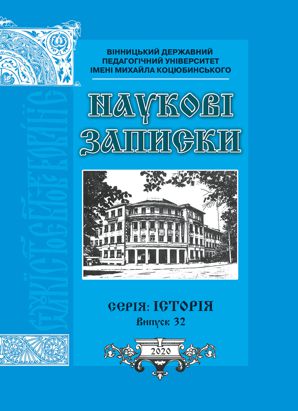Abstract
The purpose of the article is to determine the main directions of social and political activities of rural women in Volyn during the period of deployment of the policy of collectivization in agricultural economy in the late 1920s - early 1930s. The research methodology is based on general scientific (analysis, synthesis, abstraction and generalization) and specifically historical methods (historical-typological, historical-systemic and method of diachronic analysis of socio-historical reality) in combination with the principles of historicism, objectivity, systematic and development. The scientific novelty of the research is as follows. For the first time the subject of the study was rural women in Volyn during the first Stalinist Five-Year Plan. The main factors which influenced the dynamics of the inclusion of Volyn peasants in the process of socialist transformations in the village are identified. The author determines the forms and ways of involving activists women in the organization of agitation and propaganda work among their fellow villagers on their participation in local council elections, elimination of illiteracy, struggle against "class hostiles" in the village and creation of collective farms. Conclusions. During the 1920s, the Soviet government paid considerable attention to solving the so-called "women's issue." During the deployment of the course for the socialist reorganization of the village, women's departments activated their efforts to involve activists women in the process of implementation the tasks of the Bolshevik Party, primarily regarding creation of collective farms. In the period studied there were following important vectors of social and political activities of women in Volyn villages: 1. Political socialization of peasant women by involving them in local council elections; to work in village councils as part of both departments, deputies and officials (chairmen and secretaries of village councils). 2. Participation in the campaign to eliminate low literacy and illiteracy among adult population, whose literacy rate in this region was one of the lowest in Ukraine. 3. Carrying out an agitation and propaganda campaign to support the Stalin's policy of collectivization of agricultural economy and the struggle against the "class-hostile elements" of the village.
References
Codie, Barry (2016). Wife, mother, soldier, worker: depictions of peasant women in soviet propaganda. A thesis submitted in partial fulfillment of the requirements for the concentration of art history at the University of Dallas, 66 p.
ДАЖО. Державний архів Житомирської області.
Земзюліна, Н. (2013). Ідеологічні та правові механізми формування гендерного паритету в СРСР. Вісник Черкаського університету. Серія: Історичні науки, 2, 132-139.
Земзюліна, Н. (2009). Шляхи соціалізації жінок в Радянській Україні 20-х – 30-х. ХХ ст. Гуржіївські історичні читання: Зб. наук. пр., 3, 324–329.
Коршунова, Н. Е., Плотникова, В. М. (2016). Трансформация государственной политики Советского Союза по проблеме положения женщин в социальной и общественно-политической сферах. Вестник ВГУ. Серия: история. политология. Социология, 4, 55–59.
Лабур, О. (2010). «Нова жінка»: унормовані образи жінки-суспільниці і жінки-трудівниці в радянській літературі України 1920–1930-х років. Краєзнавство, 3, 205-213.
Маля, М. (2000). Радянська трагедія: історія соціалізму в Росії 1917-1991. Київ: Вид-тво «Мегатайп», 608 с.
Мельник, М. Становлення сільських рад у 20-30-х рр. ХХ ст. http://mk.archives.gov.ua/pubonsite/235-pubstansil.html
Міттінглі, Дарія. «Жінки в колгоспах – велика сила»: хто вони – українські призвідниці Голодомору? http://uamoderna.com/md/mattingly-women-in-kolkhoz
Нагорна, Н. (2011). Соціальні виміри політики більшовиків щодо емансипації жінок у 1920-х роках (на матеріалах компартійних відділів для роботи серед робітниць і селянок УСРР). Українознавчий альманах, 6, 128-136.
Нагорна, Н. (2009). Жіночі делегатські збори в УСРР: мета і сутність функціонування, організаційна структура, значення (1920-1933 рр.). Література та культура Полісся : зб. наук. праць, 56, Ніжин: Вид-во НДУ ім. М. Гоголя, 267–289
Непіпенко, Л. (2019). Гендерна ідеологія та гендерна політика в радянській політичній культурі України періоду НЕПу. Гілея: науковий вісник, 145, 116-123.
Олійник, Н. (2015). Емансипація жінок по-радянськи: особливості та наслідки. Грані, 6, 144-15.
Пошали, І. (2015) В. Радянські жінки : суспільно-правовий статус та реальне становище в Україні в 20-ті роки ХХ століття. Життя і пам’ять: науковий збірник, присвячений пам’яті В’ячеслава Івановича Шамко, Одеса: Homeless Publishing, 2, 153-160.
Пушкарева, Н. (2012). Гендерная система Советской России и судьбы россиянок. Новое литературное обозрение, 117, 8-23.
Сапицька, О. (2007). Сільські жінки України в період підготовки та проведення суцільної колективізації (1928 – середина 1933 рр.): (дис. … канд. іст. наук: 07.00.01 – Історія України). Луганськ, 199 с.
ЦДАГО України. Центральний державний архів громадських об’єднань України.

This work is licensed under a Creative Commons Attribution 4.0 International License.
Copyright (c) 2020 Scientific Papers of the Vinnytsia Mykhailo Kotsiubynskyi State Pedagogical University. Series: History





